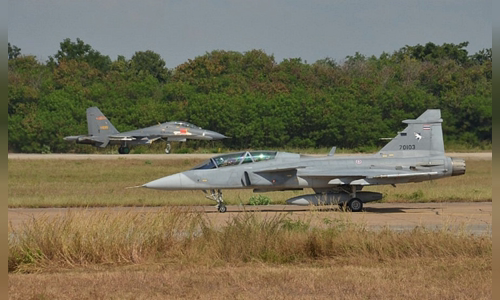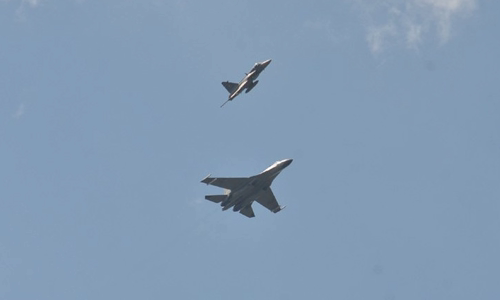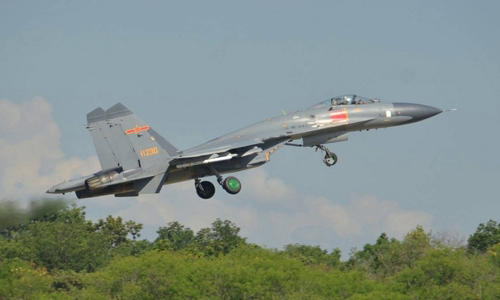Chinese fighters repeatedly lost to Thai fighters during Falcon Strike 2015 maneuvers because of old tactics and inexperienced pilots.
Colonel Li Chunghua, one of the most experienced pilots in the Chinese Air Force, revealed a series of unpublished information about the Falcon Strike maneuvers in Thailand in a lecture at Northwestern University of Technology. last month.

Chinese Su-27SK (far) and JAS 39D Thailand in the drill Photo: RTAF
The event, held at Thailand's Korat Air Base in November 2015, was the first time the two countries conducted joint military exercises. China deployed Su-27SK heavy fighter and J-11A clone. The only difference is that the J-11A has an additional missile firing channel using the active radar detector RVV-AE, while the Su-27SK can only use missiles carrying R-27 passive radar probes.
Thailand used 12 JAS 39C / D Gripen light fighters to take part in the drills and confront Chinese fighters in mock air battles.
The Chinese Air Force overwhelmed the enemy when it shot down 25 Gripen and lost only one Su-27SK fighter during the first two days of melee combat exercise. However, the situation completely reversed in the remaining 4 days of the exercise, when it shifted to long-range combat content and fixed target protection.
Colonel Li's report showed that Chinese fighters had 86% of their targets within a range of less than 30 km, 14% within 30-50 km, and no Thai aircraft within 50 km. Meanwhile, the Gripen squad's target kill rate of 12%, 64% and 24%, respectively, helped them win with a score of 41-9.

Thai and Chinese fighters flew in formation during the last day of rehearsals Photo: RTAF
"Chinese pilots have poor awareness of the situation. They are too focused on the front, instead of the surroundings. The coordination between the aircraft responsible for the attack and the aircraft escorting them is also very good. poor, "Colonel Li stressed.
For large-scale dogfights, the JAS 39 fighter could take down the target of Chinese J-11A and Su-27SK fighters. The Chinese aircraft, meanwhile, faces many difficulties and is almost impossible to penetrate the defense network of the Thai squadron.
"JAS 39C / D has a radar cross-section (RCS) of about 1.5-2 square meters, this is a very important factor when confronting Su-27SK fighters with RCS up to 12 square meters. can launch 4 medium-range air-to-air missiles AIM-120, while J-11A can only fire RVV-AE each, "Colonel Li said.
Experts say that the Su-27SK and J-11A take advantage of the melee thanks to the optimal aerodynamic design for this mission, combined with two powerful AL-31F jet engines. They are also equipped with R-73 short-range air-to-air missiles with the ability to shoot in the direction of the pilot, while JAS 39s only carry the outdated AIM-9L missiles and have not been commissioned for the dark IRIS-T line. new.

A J-11A takes off for rehearsals Photo: RTAF
Although overwhelming in close combat, Chinese pilots also receive a lot of lessons from the enemy. Their tactics were simplified and easily reconciled when Thai fighters took advantage of the Sun to conceal the infrared signal, Chinese pilots taking advantage of the offensive position often rushed to shoot down the item. pepper and fall into the opponent's trap.
"The Chinese side lack experience in 2-on-2 situations, pilots often underestimate the threat and do not apply adequate measures to avoid missiles. Meanwhile, Thai pilots make full use of bait. and mobile maneuvering, which helps reduce the risk of being shot down, "Li added.
The Chinese Air Force achieved better results in subsequent exercises by deploying J-10A and J-10C light fighters in place of the J-11A fleet. Colonel Li believes that the J-10C is as good as the JAS 39C / D thanks to the active electronic scanning array radar (AESA), which carries the PL-15 long-range missile and has a significantly smaller RCS than its counterparts. J-11A.
"The information published by Li is unprecedented and is being evaluated by US intelligence. It also shows Beijing's anxiety about the limitations of China's training of fighter pilots," military expert Reuben Johnson commented.



 YosephShiferaw
YosephShiferaw







